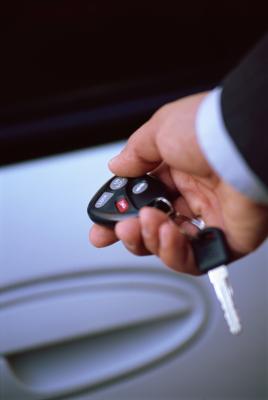
Remote-control key fobs are just one of those modern conveniences that we see every day but don't often think about unless something goes wrong. Like everything else on your car, trust that the fob system will eventually require attention of some sort; but don't freak out. There are several possible reasons why your fob is not working.
Your key fob is essentially a radio transmitter. Key fobs typically use a flat-cell battery similar to but larger than those used in watches, and they're usually not rechargeable. The key fob doesn't use much power, but you'll drain it a little every time you unlock the doors, auto-start the car or chirp the finder to scare the cats. These batteries, like all others, will also eventually self-discharge even if you never use the fob. Call it engineered obsolescence if you'd like, but some manufacturers actually glue the fob case together so that battery replacement is physically impossible; in cases like this, you're supposed to buy a new fob and pay to re-sync it to the car. Of course, you could always cut the fob open with a Dremel, replace the battery and save yourself a hundred bucks.
Your car uses a small transceiver in the cab to pick up signals from the fob and tell the doors to lock or unlock. That transceiver requires a small but constant amount of power so that it can stay continuously ready to receive the signal from your fob. Many cars have a "sleep mode" programmed into the computer that will shut down everything except for the computer's memory circuit if the car's been sitting for more than a few days. If your car utilizes a sleep mode to reduce battery discharge during storage, then physically unlocking the door with your key should bring the transceiver back online. If the transceiver still doesn't come back online, check the unit's power-supply fuse.
Key fobs and transceivers use a system of synchronized, "rolling" codes to unlock the doors. Think of the rolling code as key that changes every time you use the fob. The first time you use it, the fob may transmit "12345," and the next time it'll be "54321"; the transceiver knows that 54321 is the next code in sequence behind 12345. This means that the two must remain in constant sync in order to interact, and that can be a problem if your car battery or fob battery dies or experiences a temporary interruption in power. A strong enough magnetic or electrical field can also scramble the fob's memory, either resetting it and throwing it out of sync or erasing it outright.
If you replace the battery in your fob and check the transceiver fuse to ensure that the system itself is working, then odds are that your fob and transceiver have gone out of sync. Procedures for re-syncing the two vary, some resembling the automotive equivalent of the Hokey Pokey. For example, the reprogram procedure for the 2004 Toyota Sienna is to open the driver-side door, insert and remove the ignition key twice within 5 seconds, shut the door and open it twice, insert the ignition key and remove it, open and close the door twice, insert the ignition key, close the door then turn the key on and off. If your manufacturer doesn't have a reprogramming procedure like this, you may have to take the car to a dealership to have the two re-synced.